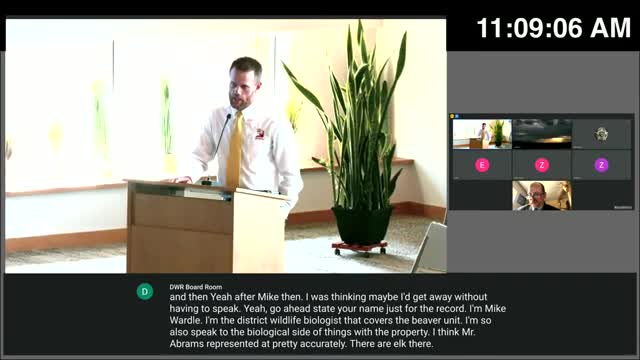Wildlife Management Strategies Spark Debate Over Hunting Practices
August 22, 2024 | Wildlife Resources, Utah Environment, State Agencies, Organizations, Utah Executive Branch, Utah
This article was created by AI summarizing key points discussed. AI makes mistakes, so for full details and context, please refer to the video of the full meeting. Please report any errors so we can fix them. Report an error »

In a recent government meeting, wildlife management strategies and hunting regulations were at the forefront of discussions, particularly concerning elk and cow populations in designated areas. A wildlife surveyor reported conducting pre-season classifications each summer, observing between 50 to 150 cows on or near the property. Notably, during a winter elk survey flight, over 200 elk were spotted in October, indicating the area’s robust habitat.
Concerns were raised regarding the impact of hunting on cow populations, with discussions highlighting the need for innovative approaches to manage hunting pressure effectively. The potential for boundary confusion between public and private lands was also a significant topic, as law enforcement officials noted that the irregular property lines complicate enforcement efforts. Suggestions were made to improve boundary clarity, particularly in collaboration with the Forest Service.
The meeting also addressed hunting strategies on surrounding properties, confirming that the area operates under a limited entry elk unit. This regulation aims to manage hunting pressure, especially during the fall when spike hunters and big bull hunters are most active.
Participants explored alternative hunting options, including public landowner draws and mitigation permits for cow elk hunts. The possibility of selling trespass fees for hunting access was also mentioned as a potential revenue stream for landowners.
Overall, the discussions underscored the importance of sustainable wildlife management practices and the need for clear communication between landowners, hunters, and regulatory bodies to ensure the health of elk populations and the integrity of hunting practices.
Concerns were raised regarding the impact of hunting on cow populations, with discussions highlighting the need for innovative approaches to manage hunting pressure effectively. The potential for boundary confusion between public and private lands was also a significant topic, as law enforcement officials noted that the irregular property lines complicate enforcement efforts. Suggestions were made to improve boundary clarity, particularly in collaboration with the Forest Service.
The meeting also addressed hunting strategies on surrounding properties, confirming that the area operates under a limited entry elk unit. This regulation aims to manage hunting pressure, especially during the fall when spike hunters and big bull hunters are most active.
Participants explored alternative hunting options, including public landowner draws and mitigation permits for cow elk hunts. The possibility of selling trespass fees for hunting access was also mentioned as a potential revenue stream for landowners.
Overall, the discussions underscored the importance of sustainable wildlife management practices and the need for clear communication between landowners, hunters, and regulatory bodies to ensure the health of elk populations and the integrity of hunting practices.
View full meeting
This article is based on a recent meeting—watch the full video and explore the complete transcript for deeper insights into the discussion.
View full meeting

